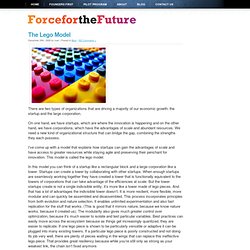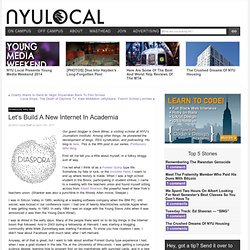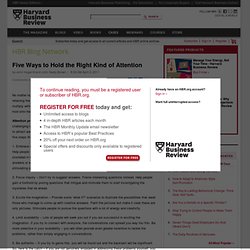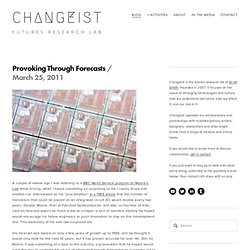

SEEK Jazz Hands Moments: August 29, 2013. OKFestival. The Lego Model « Force For the Future. There are two types of organizations that are driving a majority of our economic growth: the startup and the large corporation.

On one hand, we have startups, which are where the innovation is happening and on the other hand, we have corporations, which have the advantages of scale and abundant resources. We need a new kind of organizational structure that can bridge the gap, combining the strengths they each possess. I’ve come up with a model that explains how startups can gain the advantages of scale and have access to greater resources while staying agile and preserving their penchant for innovation.
This model is called the lego model. In this model you can think of a startup like a rectangular block and a large corporation like a tower. Towers only have to live as long as they are still creating increasing value for the customer. What we don’t want are companies trying to milk past innovations for all they are worth, through monopolies and legal manuerving. An eBay for science. WeekendHacker. Let’s Build A New Internet In Academia. Our guest blogger is Dave Winer, a visiting scholar at NYU’s Journalism Institute.

Among other things, he pioneered the development of blogs, RSS syndication, and podcasting. His blog is here. This is the fifth post in our series, Professors Who Blog. First let me tell you a little about myself, in a folksy bloggy sort of way. I’ve led what I think of as a Forrest Gump type life. I was in Silicon Valley in 1980, working at a leading software company when the IBM PC, still secret, was locked in our conference room. I was at Wired in the early days. Anyway, all of that is great, but I want to talk about another Forrest Gump type experience I had, when I was a grad student in the late 70s at the University of Wisconsin. A bunch of important new things were sprouting in this rich new environment. An aside, what made all these things work so well is that they were empty inside.
I had role models for success. The development of the Internet must continue. Will your generation be lost? Five Ways to Hold the Right Kind of Attention - John Hagel III and John Seely Brown - John Hagel III and John Seely Brown. By John Hagel III and John Seely Brown | 8:26 AM April 5, 2011 No matter how talented or accomplished you are, you cannot always count on attracting and retaining the attention of others.

Too many options compete for everyone’s attention, and they multiply with each passing day. It will be more and more challenging to rise above the noise and hold onto the attention of those who matter to you. Attention provides leverage. The more people we can attract and motivate to join us on a challenging quest or initiative, the more impact we are likely to achieve. 1. 2. Open Projects: What websites help you start, plan, and run open projects.
We keep things fair. PlanBig: A place for sharing plans and ideas to make them happen. Social business for everybody. CommonDeeds - Home. IfWeRanTheWorld. OpenHatch - Community tools for free and open source software. Lighthouse - Beautifully Simple Issue Tracking. Epic.IO. 1. Intentcasting. {*style:<i> Each post in the 'Blueprints for Networked Cocreation' series will describe a capability that is necessary for open, creative collaboration and give examples of tools that instantiate that capability. The blueprints are free for anyone to pick up, use or reuse. The first capability we will look at is intentcasting. </i>*} </i>*} Interest brings groups together, but is what brings together to actually get things done. is deceptively simple to describe. "I want to have a party at my house!
" "We want to raise $1,000 for Japan! " Provoking Through Forecasts - Blog - Driving Better Futures. A couple of weeks ago I was listening to a BBC World Service program on Moore's Law while driving, when I heard something so surprising to me I nearly drove into another car.

Interviewed on his "proclamation" in a 1965 article that the number of transistors that could be placed on an integrated circuit (IC) would double every two years, Gordon Moore, then at Fairchild Semiconductor and later co-founder of Intel, said his forecast wasn't as much a law as a hope—a sort of manifest destiny he hoped would encourage his fellow engineers to push innovation to stay on this development line. This backstory of his own law surprised me. His forecast was based on only a few years of growth up to 1965, and he thought it would only hold for the next 10 years, but it has proven accurate for over 40. Why is this important? It is a great illustration of the complex, sometimes misunderstood, relationship—and often blurry lines—between forecasts, predictions, and provocations.
Intention Broadcasting.